
Venice is a city in northeastern Italy and the capital of the Veneto region. It is built on a group of 126 islands that are separated by expanses of open water and by canals; portions of the city are linked by 472 bridges. The islands are in the shallow Venetian Lagoon, an enclosed bay lying between the mouths of the Po and the Piave rivers. In 2020, around 258,685 people resided in greater Venice or the Comune di Venezia, of whom around 51,000 live in the historical island city of Venice and the rest on the mainland (terraferma). Together with the cities of Padua and Treviso, Venice is included in the Padua-Treviso-Venice Metropolitan Area (PATREVE), which is considered a statistical metropolitan area, with a total population of 2.6 million.

The Venetian Lagoon is an enclosed bay of the Adriatic Sea, in northern Italy, in which the city of Venice is situated. Its name in the Italian and Venetian languages, Laguna Veneta—cognate of Latin lacus, "lake"—has provided the English name for an enclosed, shallow embayment of salt water, a lagoon.

The Lido, or Venice Lido, is an 11-kilometre-long (7-mile) barrier island in the Venetian Lagoon, Northern Italy; it is home to about 20,400 residents. The Venice Film Festival takes place at the Lido late August/early September.

Cannaregio is the northernmost of the six historic sestieri (districts) of Venice. It is the second largest sestiere by land area and the largest by population, with 13,169 people as of 2007.
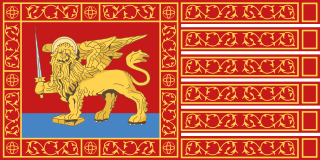
The Republic of Venice, traditionally known as La Serenissima, was a sovereign state and maritime republic with its capital in Venice. Founded, according to tradition, in 697 by Paolo Lucio Anafesto, over the course of its 1,100 years of history it established itself as one of the major European commercial and naval powers. Initially extended in the Dogado area, during its history it annexed a large part of Northeast Italy, Istria, Dalmatia, the coasts of present-day Montenegro and Albania as well as numerous islands in the Adriatic and eastern Ionian seas. At the height of its expansion, between the 13th and 16th centuries, it also governed the Peloponnese, Crete and Cyprus, most of the Greek islands, as well as several cities and ports in the eastern Mediterranean.
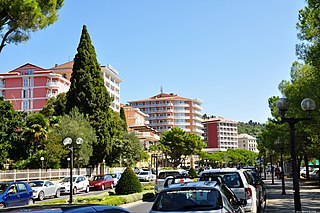
Portorož is a Slovenian Adriatic seaside resort and spa settlement located in the Municipality of Piran in southwestern Slovenia. Its modern development began in the late 19th century with the vogue for the first health resorts. In the early 20th century Portorož became one of the grandest seaside resorts in the Adriatic, along with Opatija, Lido and Grado, then as part of the Austrian Littoral. It is now one of Slovenia's major tourist areas. Located in the centre is the Palace Hotel, once one of the most important resorts for the Austro-Hungarian monarchy, and currently one of the finest hotels between Venice and Dubrovnik.

Sottomarina is a small town on a peninsula which has the same name. It is a frazione of the comune of Chioggia, which is part of the Metropolitan City of Venice in the Veneto region in north-eastern Italy.
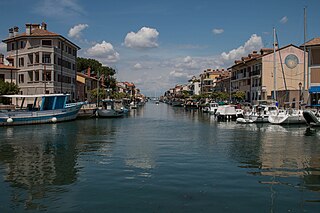
Grado is a town and comune (municipality) of 8,064 residents in the Regional decentralization entity of Gorizia in the north-eastern Italian region of Friuli-Venezia Giulia, located on an island and adjacent peninsula of the Adriatic Sea between Venice and Trieste. The territory of the municipality of Grado extends between the mouth of the Isonzo and the Adriatic Sea and the Grado Lagoon, and covers an area of about 90 square kilometers between Porto Buso and Fossalon. Characteristic of the lagoon is the presence of the casoni, which are simple houses with thatched roof used in the past by the fishermen of Grado, who remained in the lagoon for a long time, returning to the island of Grado only during the colder period of the year.

JW Marriott is an American luxury hotel brand owned by Marriott International.
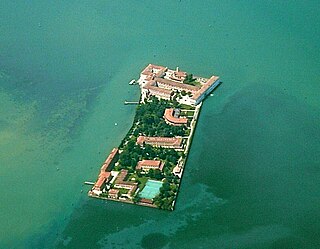
San Servolo ['sɛrvolo] is an Italian island in the Venetian Lagoon, to the southeast of San Giorgio Maggiore. Earlier housing a monastery of Benedictine monks, later an asylum for the insane, the island is now home to a museum and Venice International University.

Matteo Thun is an Italian architect and designer.

Santa Maria della Grazia or La Grazia is an artificial island of the Venetian lagoon, northern Italy, which lies between the Giudecca and San Clemente.

Jesolo is a seaside resort town and comune of 26,447 inhabitants in the Metropolitan City of Venice, Italy. With around six million visitors per year, Jesolo is one of the largest beach resorts in the country, and ranks 7th overall as a tourist destination, and fourth most popular Italian seaside resort. With 204,711.4 visits per thousand inhabitants, it is also one of the 50 Italian towns with the greatest tourist pressure. Its 15 kilometres of beaches and proximity to central Europe make it a favourite destination of many German, Austrian, Dutch and French visitors.
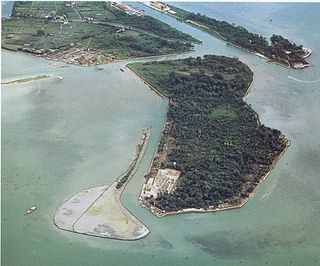
La Certosa is an island in the Venetian Lagoon, northern Italy. It is located northeast of Venice, fewer than 250 metres from San Pietro di Castello and little more than 500 metres from the Venice Lido. A 20-metre-wide (66 ft) channel separates it from the Vignole island. La Certosa has a surface of some 22 hectares.
Isola di San Clemente is a small island in the Venetian Lagoon in Italy. For centuries it housed a monastic settlement, and more recently an asylum. It is now the site of a luxury hotel.

The Ponte dei Tre Archi is one of the main bridges of Venice, Italy, along with the Ponte delle Guglie, the other bridge spanning the Cannaregio Canal, and the four bridges spanning the Canal Grande: Rialto, Scalzi, Accademia, and the Costituzione. It is located in Cannaregio district (sestiere), just South of Rio San Giobbe, linking the fondamenta San Giobbe, and the South-West area of Cannaregio, to the fondamenta di Sacca San Girolamo and the North-East of Cannaregio. As all other Venetian bridges, the Ponte dei Tre Archi is a pedestrian walkway.

Marano Lagoon is a huge lagoon in northeastern Italy. It has a surface area of around 160 square kilometres.
The following is a timeline of the history of the city of Venice, Veneto, Italy.
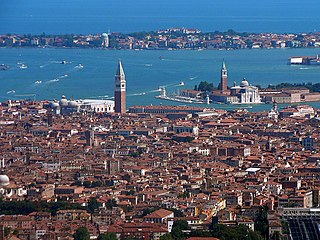
The Metropolitan City of Venice is a metropolitan city in the Veneto region of Italy, one of ten metropolitan cities in Italy. Its capital is the city of Venice. It replaced the province of Venice in 2015 and includes the city of Venice and 43 comuni. It was first created by the reform of local authorities and then established by Law 56/2014.


















